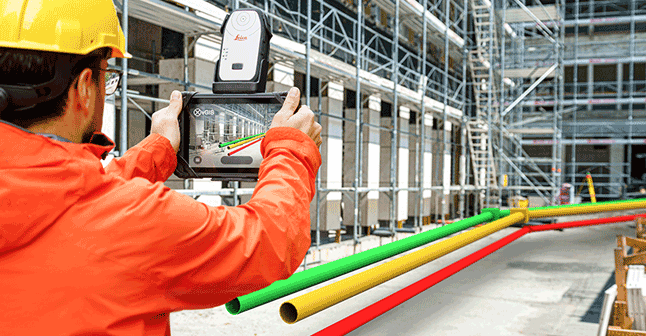Augmented Reality (AR) has the potential to transform construction site operations, enabling non-specialists to view 3D models in the real environment and complete tasks like locating utilities, checking build progress against specifications and applying ground markings.
However, there’s one crucial catch: the best as-built 3D models are only as good as the location accuracy in the field. 3D models are created using precise coordinates and the AR platform needs a reliable way to know exactly where the user is to orient the visualisation to the environment. This is where Leica Geosystem’s lightweight smart antenna, the Leica Zeno FLX100, brings several benefits to the performance of AR in construction.
In a recent field test, Esri Suisse, a specialist in geographic information systems (GIS) and smart mapping, paired the FLX100 with a cloud-based mapping program and an AR platform to determine the impact the smart antenna would have on AR functionality in the construction context. After a day of testing, the Esri Suisse team concluded that by providing a high level of location accuracy, “the Zeno FLX100 makes the difference.”
This blog will review the field test and conclude with future-oriented applications for the construction industry.
Test goals and design
When Esri Suisse set out to test a 3D model with AR in the field, their focus revolved around two main questions:
- Was it user-friendly for non-surveying specialists?
- Can users rely on AR visualisations to accurately navigate the real environment?
Partnering with engineering firm Ackermann + Wernli, Esri Suisse used a variety of data, including computer-aided design (CAD) plans, 3D building information modelling (BIM) objects and reality capture, to create a 3D model of Biberstein, a small town located along the Aar River in northern Switzerland.

Two different perspectives of the 3D model in ArcGIS – the first focusing on utilities and the second on designed buildings, depicted in grey
The model, generated in the cloud-based digital mapping platform ArcGIS Online, featured structures (real and designed), topography, and utility lines.
The 3-D model was then incorporated into vGIS’ AR visualisation platform to create a digital version (often called a digital twin) that the team could view and interact with on their tablets in real-time, accessing a range of information and viewing options depending on the task.
To complete the test set-up, Esri Suisse chose the FLX100 to connect with GNSS spatial data and obtain accurate positioning. The antenna and tablet functioned as one unit with the FLX100’s universal handheld tray. For comparison, this was used alongside the same AR platform on a tablet without an antenna or GNSS capabilities.
Testing utility location and project plans with AR
Greeted with rain and grey skies in Biberstein, the Esri Suisse team began the AR assessment by searching for utility lines in a residential area. The FLX100 quickly facilitated high accuracy location calibration and once the AR platform confirmed precise positioning within a few centimetres, the screen populated with a labyrinth of colour-coded underground infrastructure assets. Each asset was uniquely identified and included information like depth and dimensions.
The test team easily filtered through and customized the information on-screen by selecting layers to represent different types of infrastructure lines, easily distinguishing between electricity, water, cables, and others. To confirm the accuracy of the AR visualisation, they followed an underground water line to an above-ground hydrant. The real hydrant aligned with its digital twin nearly identically.
To facilitate the second part of their test, the Esri Suisse team created two new construction designs in the 3-D model of Biberstein to demonstrate how AR could work with plans on future and ongoing construction projects. As they interacted with the design visualisations at the imagined build site, the structures were positioned quickly, precisely and with correct dimensions.
Performance with the smart antenna: A comparison
The testing scenarios had another element: the team compared the AR platform on a tablet using internal GPS only with the tablet FLX100 pairing in the handheld tray.
They found that with GPS alone, establishing accurate location was difficult and unstable, with a deviation of several metres. Maintaining accuracy required frequent manual adjustments for position, altitude, and direction.
However, positioning with the FLX100 was an entirely different experience. Location calibration was rapid and stable, accuracy was high with only a 0-2-centimetre deviation, and no manual adjustments were necessary. The team found this increased the usability of AR, saved time and enhanced user-friendliness.
Applications for the construction industry
What can construction managers take away from these findings?
AR can help communicate design plans and underground infrastructure location to construction foremen and other site workers, allowing non-specialists to clearly understand information that is less accessible in paper formats. For example, using AR eliminates confusion about the direction of build plans or a worker’s current location in relationship to the design. It also enables workers to precisely locate and trace utilities.
The user-friendly access to this information through visualisation allows a broader range of site-personnel to carry out important tasks on the construction site, including quality control, reporting on build progress and applying ground markings. AR also helps reduce costly mistakes, like accidentally excavating and damaging utility lines. Tasks can be completed faster and, when more people are equipped to perform them, there is no need to wait for specialists.
As the test demonstrated, pairing an AR program with the small but powerful FLX100 GNSS smart antenna makes positioning certain and easy, enabling the time and cost-saving features of AR for construction operations.
Click here to learn how easy it is to set up and incorporate the FLX100 into your AR or other digital visualisation.














